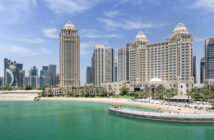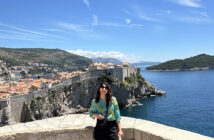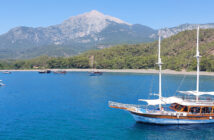BY FARIHA ESHRAT AND MARIA COMETTI
If you’re looking for a country with both an ultra-modern capital city and a rich cultural tapestry, look no further than Korea. Seoul is one of the fastest growing metropolitan cities in the world, and houses numerous temples, palaces, mountain trails, a cutting-edge digital media city and the world’s largest indoor amusement park. Truly a place for everyone to enjoy, the country has 3,500 picturesque islands and is an upcoming global fashion, music, and media hub. Korea is truly a kaleidoscope with its myriad of offerings and surprises!
Bilateral Relations
Korea and the Kingdom of Saudi Arabia have maintained a remarkable friendship for over half a century. Since the establishment of diplomatic ties in 1962, the relationship has steadily strengthened. This long standing partnership has been growing, from 20 million USD in 1968 to a bilateral trade relation worth 24.7 billion USD in 2017. This unprecedented momentum is a clear example of the most enduring bilateral relations. As of 2017, the Kingdom is Korea’s ninth largest trade partner and Korea is the Kingdom’s 5th largest trade partner.
Korean architects and construction teams played a significantly role in numerous infrastructure development projects in the late 1970s. Over 200,000 Koreans were then employed in the Kingdom, as they constructed monumental structures such as the buildings of the Ministry of Defense, Ministry of Foreign Affairs, Jubail Industrial City, King Saud University and more. The total value of the Saudi investment in Korea is about USD 2 billion from 2006 to 2017, while the total value of the Korean investment in Saudi Arabia during the same period is about USD 4 billion. Currently, cars, auto parts, electronic goods, steel and textiles are the major Korean exports to Saudi Arabia.
As Saudi Arabia is ambitiously pursuing a new future of the Kingdom under the Vision 2030, this bilateral relationship is also entering a new historic chapter. As a strategic partner of Vision 2030, Korea is keen to share with Saudi Arabia its experience and lessons learned during the economic development process. Moreover, as Vision 2030 spurs exciting economic opportunities in Saudi Arabia, the two countries are rapidly expanding cooperation into diverse sectors such as healthcare, renewable and nuclear energy, smart cities, e-government, SMEs and capacity building. Most of these areas directly touch upon the daily lives of the Saudi people. They are also central to the Saudi government’s job-creation initiatives.
Current projects
Within the framework of Vision 2030, Korea and Saudi Arabia have identified 40 joint projects for partnership opportunities, and the two countries set up a Vision 2030 joint committee in 2017 to oversee these joint projects. These projects include training the next generation of Saudi e-government specialists, strengthening the Kingdom’s health insurance system, and building a state-of-the-art shipbuilding plant on the east coast of Saudi Arabia.
Additionally, the Korean mission is working to share expertise in the renewable energy sector and cooperating in the construction of smart cities & smart airports. In particular, Korea hopes to help diversify Saudi Arabia’s energy portfolio by participating in its nuclear energy programs.
As of 2018, more than 36 Korean companies operate with branch offices in Saudi Arabia including Samsung and Hyundai Motors. Currently, 11 Korean construction companies are carrying out a total of 35 projects in close cooperation with their Saudi counterparts.
Cultural exchange programs
Korean-Arabian bilateral relations existed for over thousands of years, with cultural exchanges communicated through the silk roads. Reviving this old tradition, the intention to promote more bilateral cultural exchanges in order to further deepen the mutual understanding and good will between the Koreans and the Saudis is now done in close consultation with the General Culture Authority (GCA).
As the first project of a series of cultural exchanges that are being planned, Korean traditional dance teams and modern dancers of B-boy were invited to perform in King Fahd Cultural Center on October 14. The event was a huge success and fascinated the Saudi people, with over 2, 300 Saudi audience members filling up the largest hall of the KFCC and reserving all the seats in just 3 days. Inspired and encouraged by such a great success with the first project, the Korean Embassy and GCA are currently discussing a series of cultural events for the next stages.
The second cultural project is a special upcoming exhibition at the Riyadh National Museum in collaboration with the Korean National History Museum and the Saudi Commission for Tourism and National Heritage (SCTH) to bring 250 archeological artifacts in relation to the Kingdom and the Middle East to showcase the items. This is part of the cultural exchange program between the Kingdom and Korea. Last year, there was an exhibition in Seoul named Roads of Saudi Arabia that lasted 3 months, which was a huge success and attracted tens of thousands of Korean visitors. Ambassador Jo ByungWook wants to replicate the success and provide an exciting opportunity for many Saudis to look and feel the Korean culture and history. The exhibition’s current tentative opening ceremony date is on December 18, 2018 and it will last for 3 months.
The Embassy also recently hosted a Korean Language Competition on November 5, 2018. Over 50 Saudis applied and selected candidates had a contest on the event day and won prizes. The 12 finalists and their families, along with all the participants, enjoyed their experience of Korean culture and cuisine.

Where To Go
- Gyeongju is a cultural hub outside Seoul, known for its traditional Korean villages, temples and cultural centers. Learn more about the 5000 years of history and culture woven into the Korean traditions you see today.
- Hwaseong Fortress in Suwon was built in the 18th century by King Jeongjo and the plaza in-front of the palace grounds now hosts traditional cultural performances almost everyday.
- Changdeokgung in Seoul is a 14th century palace, known as the most beautiful palace in the capital city and renowned for its beautiful hidden garden and moonlight tours.
- Jeju Island, also known as the Isle of the Gods, is a tropical beauty with relaxing beaches, gorgeous waterfalls, and the famous Sunrise Peak. Take a tour across the most famous of Korea’s 3500 islands to learn more about all the ancient folklore based on this location.
- Lotte World in Seoul is the world’s largest indoor amusement park. A fun stop for all ages, this is a must see on your trip across Korea. Every year during the summer months, the Gyeongbokgung Palace opens up to the public for a special night viewing.
What To Do
- Shopping in Seoul is a tourist favourite as it houses ex.quisite high-end fashion, luxury goods, indie and vintage stores and also wholesale retail. Korean cosmetics, skincare, traditional crafts and streetwear are a growing international trend and the Dongdaemun shopping district is a one stop wonder. With 26 malls and 30,000 stores, you will definitely shop until you drop on your visit here.
- Korean Cuisine Tours is a great way to learn about Korean culture. Gwangjang in Seoul is a bustling food scene with 200 or so food stalls where you can experience traditional dishes like kimchi, fresh seafood, dumplings, mung bean pancakes or even the exotic sannakji (raw octopus tentacles).
- Winter Sports at any of the Pyeongchang resorts is a thrilling tour stop. You can enjoy skiing, sledding or ice skating with your family and friends and visit the site of the 2018 Winter Olympics.
- Hallyu tours of the Korean entertainment business and culture provides fans of K-pop and K-drama with state-of-the-art hologram technology at the K-Style Hub, a complete hallyu culture center. Meet Bigbang, Psy, and other hallyu stars through these permanent experience centers.
- Spas and hot springs have been used since ancient times by Koreans to relieve stress and recover from fatigue, muscular pain and many other ailments. Korean beauty regimens are a must-try, with promising results.
About the Ambassador Jo ByungWook
Embassy of Korea

How did you become a diplomat?
When I graduated from the Korean military academy, I was naturally interested in national security and national interests. After briefly serving in the Korean military, I quickly realized that national security and national interests are not only guaranteed by military personnel but the brotherhood of international relations. This prompted me to join the foreign service. I found great honor in representing my country internationally and have been grateful to serve the nation. I have always been fascinated with meeting new people and experiencing different cultures.
Tell us more about how you came to be posted in Saudi Arabia
I have been in the service for 33 years. My first post was in Washington DC, around 30 years ago. Since then I’ve been to many places; one of my previous posts was in Ottawa, Canada. The weather there was very interesting with wind chill sometimes reaching -40 degrees Celsius. They had long, cold winters: two weeks of unshoveled snow would be 2 storeys high. When I arrived in Ottawa in late March 2008, my predecessor told me that there are only two seasons in Ottawa: winter and construction season to repair the dam.age salting snow had done to the streets. After that, I really needed some warm weather and I was very excited to come to Saudi Arabia.
What were your thoughts when you were assigned to become the ambassador to Saudi Arabia?
When I heard I was assigned to Riyadh, I knew this would be a new experience and felt honored and privileged to be assigned to a nation with such historic and current significant ties with my country. I realize the Kingdom is going through historic transformations and it is quite an honor to be here now in the center of it. I will not remain as a bystander of this reform process, but rather an active partner.
What do you like the most about living in Riyadh?
I feel very proud to be here, especially when I come across historic and monumental signature architecture built by Korean architects like the Ministry of Foreign Affairs, Ministry of Defense, King Saud University, Jubail Industrial City. About three months ago, I met with the governor of the Eastern Province, and he told me that he remembers how industrious and hard working Korean people working on these structures were. He said that the structures still stand and look like they were built last year. These remarks made me proud and are very rewarding.
How does your typical day go?
My day starts even before I come to the office. When I wake up at around 6:00 AM, the first thing I do is check the news headlines. After this, I watch the news before I come to the office. Once at the office, I start by checking urgent messages. Then I meet my personal staff to check and fine tune my schedule of the day. After that, I have a meeting with the other staff and other meetings inside and outside the embassy. My meetings cover politics, economics, commerce, even consular affairs and culture. Finally, some of my time is also allocated to housekeeping in the embassy, like man.aging personnel and the upkeep of the embassy itself. Most evenings, I have diplomatic functions or dinners to attend which keep me occupied until the end of the day around 10 or even 11 PM.
What is the most challenging part of being the ambassador to Saudi Arabia?
What is the most rewarding? Since I am new to this culture and environment, the language has been the most difficult part for me. I want to learn more though I’m finding the Arabic alphabets quite challenging. Luckily I can read the numbers, so that I don’t have trouble on the streets with speed limit signs.
I enjoy meeting with people the most, whether they are new or old acquaintances. It’s always exciting to meet new people and cultivate a deeper friendship. That is one of the most rewarding and fascinating parts of my job. Whenever I hear encouraging remarks from Saudis, often the older generation of Saudis who remember the work of the Korean archi.tects in the Kingdom, I feel rewarded. The kindness of the Saudis has really touched my heart and I’ve enjoyed hearing many stories. I’ve even heard stories of Saudis playing soccer games with some of the 200,000 Koreans who used to work here back in the late 1970s. All of this has been a rewarding experience, and I want to cultivate our relation into a much closer one.
What do you like most about the DQ?
One of the best benefits of living inside the DQ is that my fellow ambassadors are all nearby, within walking distance, making it convenient to meet them. Initially I would walk along the trails and parks; nowadays I spend more of my free time in the Nofa Resort and Riyadh golf courses. At least once a week, my wife and I visit Scalini for its Italian food and almost every weekend we go to Pancake House. We also really enjoy visiting Oud Square, iHOP and Starbucks inside the DQ.
Embassy of South Korea
Amr Aldamri St., Al Safarat District, Riyadh
Contact Nos: 011-488-2211
Email: emsau@mofa.go.kr
Website: http://overseas.mofa.go.kr/sa-ar/index.do
Twitter: @emsaukr
Facebook: https://www.facebook.com/koreanembassyriyadh




